How To Find The Standard Deviation Of A Probability Distribution
Contents: Standard Divergence (click to skip to section):
Basics:
- Standard Deviation Definition
- How to Detect the Sample Standard Departure by Hand
More avant-garde topics:
- Standard Difference for a Binomial
- Discrete Random Variable Standard Divergence
- Standard Deviation for a Frequency Distribution
Using Applied science:
- Find the Standard Deviation in Minitab
- Notice the Standard Deviation in SPSS
- in Excel
- TI-89 Instructions
Related manufactures:
- Accented standard deviation
Definition
Standard deviation is a measure of dispersement in statistics. "Dispersement" tells y'all how much your data is spread out. Specifically, it shows you how much your data is spread out effectually the mean or average. For example, are all your scores close to the average? Or are lots of scores manner higher up (or fashion beneath) the average score?
What Does information technology Expect Like on a Graph?
The bell curve (what statisticians telephone call a "normal distribution") is unremarkably seen in statistics every bit a tool to understand standard departure.
The following graph of a normal distribution represents a great deal of data in existent life. The hateful, or average, is represented by the Greek letter μ, in the center. Each segment (colored in nighttime blue to lite blueish) represents one standard difference abroad from the mean. For case, 2σ means two standard deviations from the mean.
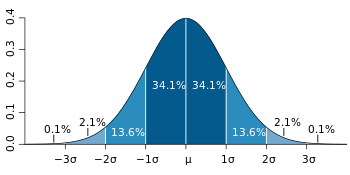
Real Life Example
A normal distribution curve can stand for hundreds of situations in existent life. Have yous ever noticed in class that nigh students get Cs while a few get As or Fs? That can be modeled with a bell curve. People'southward weights, heights, diet habits and exercise regimens can likewise exist modeled with graphs like to this one. That knowledge enables companies, schools and governments to make predictions most future behavior. For behaviors that fit this type of bell curve (like functioning on the SAT), you'll exist able to predict that 34.one + 34.1 = 68.2% of students will score very close to the average score, or one standard divergence away from the hateful.
How to Find the Sample Standard Deviation by Hand
Watch the video for an example:
Tin't see the video? Click here.
Find by Hand
When you lot're running an experiment (or examination, or survey), you lot're normally working with a sample— a modest fraction of the population. The formula to discover the standard deviation (s) when working with samples is:
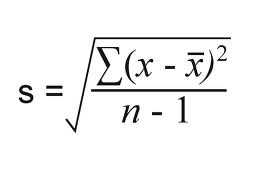
The Σ sign in the formula means "to add upwards" (see: Sigma notation). To solve the formula,
- Add the numbers,
- Square them,
- Then split.
It sounds simple, but it gets tedious when working with larger sample sizes (because you have to add and square multiple times). The example problem below has only 9 data points, only should give you a practiced example of how boring the hand calculations can exist. If you practice accept to calculate it past hand (for homework or a exam), make sure to employ a calculator to check your respond.
Example Problem:
Q. Find the standard deviation for the post-obit results:
{12, 15, 17, xx, xxx, 31, 43, 44, 54}
Step 1: Add the numbers upwards:
12 + 15 + 17 + twenty + xxx + 31 + 43 + 44 + 54 = 266.
Step 2: Square the answer from Step 1:
266 x 266 = 70756
Step 3:Divide your reply from Step 2 by the number of items (northward) in your fix. In this example, we have 9 items, so:
70756 / 9 = 7861.777777777777 (dividing by n)
Fix this number aside for a moment. You'll need it in a after step.
Step 4:Square the original numbers {12, 15, 17, 20, 30, 31, 43, 44, 54} one at a time, then add together them up:
(12 ten 12) + (15 ten 15) + (17 x 17) + (20 x 20) + (30 x 30) + (31 x 31) + (43 x 43) + (44 x 44) + (54 10 54) = 9620
Step 5: Subtract Step 4 from Stride 3.
9620 – 7861.777777777777 = 1758.2222222222226
Notice that I'yard not rounding yet. You should keep all of your decimal places until the very end, and then you can round. Rounding in the middle will atomic number 82 to your answer being off simply enough to become an incorrect textbook answer. Set this number bated for a moment.
Step 6: Decrease one from n. Nosotros have nine items, so n = nine:
9 – 1 = viii
Step seven: Separate Step 5 by Step 6 to get the variance:
1758.2222222222226 / 8 = 219.77777777777783
Step eight: Take the square root of Footstep 7:
√(219.77777777777783) = 14.824903971958058
The standard deviation is fourteen.825.
Back to Top
Need help with a homework question? Cheque out our tutoring page!
Standard Departure for a Binomial
(Click to Skip to Section)
Standard Difference For a Binomial: TI-83
Standard Difference For a Binomial: past hand
TI 83 Standard Deviation For a Binomial
Watch the video for an case:
Can't see the video? Click here.
The TI 83 doesn't have a built in function to find the standard divergence for a binomial. You have to enter the equation in manually.
![]()
Example trouble: Find standard deviation for a binomial distribution with n = 5 and p = 0.12.
Step 1: Subtract p from i to find q.
i – .12 ENTER
=.88
Footstep 2: Multiply north times p times q.
v * .12 * .88 ENTER
=.528
Footstep 3: Find the foursquare root of the answer from Stride 2.
√.528 = =.727 (rounded to 3 decimal places).
Standard Deviation For a Binomial: Past Hand
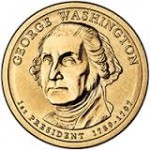
A coin toss can be a binomial experiment.
A binomial distribution is 1 of the simplest types of distributions in statistics. It'due south a blazon of distribution where there is either success, or failure. For example, winning the lottery: or non winning the lottery. You can find the standard divergence for a binomial distribution in two means:
- With a formula
- With a probability distribution tabular array (scroll down for the steps)
The formula to find the standard departure for a binomial distribution is:
![]()
Scout the video for an case:
Can't see the video? Click hither.
Instance question:
Find the standard divergence for the post-obit binomial distribution: flip a coin chiliad times to see how many heads you get.
Stride 1: Place north and p from the question. N is the number of trials (given as 1000) and p is the probability, which is .5 (you have a 50% chance of getting a heads in any money flip).
At this point you can insert those numbers into the formula and solve. If formulas aren't your forte, follow these additional steps:
Footstep ii: Multiply n by p:
m * .five = 500.
Step 3: Subtract "p" from 1:
i – .5 = .five.
Pace 4: Multiply Step 2 by Step 3: 500 * .five = 250.
Step v: Have the foursquare root of Step 4:
√ 250 = 15.81.
That's information technology!
Standard Deviation of Detached Random Variables
With detached random variables, sometimes you're given a probability distribution table instead of "p" and "due north". As long as you take a table you can calculate the standard deviation of discrete random variables with this formula:
![]()
Example question: Find the standard deviation of the detached random variables shown in the post-obit tabular array, which represents flipping 3 coins:
![]()
Footstep one: Find the hateful (this is also called the expected value) by multiplying the probabilities by x in each column and calculation them all up:
μ = (0 * 0.125) + (1 * 0.375) + (ii * 0.375) + (iii * 0.125) = 1.5
Stride 2: work the inner function of the higher up equation, without the square root:
- ((0 – 1.5)2 * 0.125 ) +
- ((1 – 1.5)ii * 0.375 ) +
- ((2 – one.v)two * 0.375 ) +
- ((three – ane.5)2 * 0.125 ) +
- = 0.75
Step iii: Take the square root of Footstep 2:
σ = √ 0.75 = 0.8660254.
That's it!
Dorsum to Top
Standard Deviation for a Frequency Distribution
Back to Peak
The formula to observe the standard deviation for a frequency distribution is:

Where:
- μ is the hateful for the frequency distribution,
- f is the individual frequency counts,
- x is the value associated with the frequencies.
Sentinel this brusk video, which shows yous how to work the formula in simple steps:
Can't come across the video? Click here.
How to find the Standard Deviation in Minitab
This video shows you how to notice the standard deviation in Minitab in one minute:
Tin't see the video? Click hither.
Example question: Find the standard difference in Minitab for the post-obit data: 102, 104, 105, 110, 112, 116, 124, 124, 125, 240, 245, 254, 258, 259, 265, 265, 278, 289, 298, 311, 321, 321, 324, 354
Stride 1: Type your information into a unmarried column in a Minitab worksheet.
Step ii: Click "Stat", so click "Basic Statistics," and so click "Descriptive Statistics."
Step 3: Select the variables yous want to find the standard deviation for and then click "Select" to movement the variable names to the right window.
Stride four: Click the "Statistics" push.
Step 5: Cheque the "Standard departure" box so click "OK" twice. The standard deviation will be displayed in a new window.
That's it!
Dorsum to Summit
How to discover the Standard Deviation in SPSS
The tool to calculate standard deviation in SPSS is constitute in the "Analytics > Descriptive Statistics" section of the toolbar. You can too use the "Frequencies" option in the same carte. The video below shows both options:
Tin't come across the video? Click here.
If you accept already typed in your data into a worksheet, skip to Step 3.
Stride i: Open a new worksheet to blazon in data. In one case SPSS opens, select the "type in information" radio button to the correct of the "What would you similar to do" dialog box.
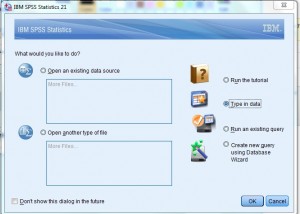
Step two: Blazon your data into the worksheet.You can use as many columns every bit you like to enter data, just don't exit any blank rows betwixt your information.
Footstep 3: Click "Analyze" on the toolbar and so mouse over "Descriptive Statistics." Click "Descriptives" to open up the variables dialog box.
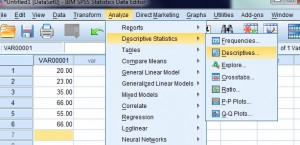
Step 4: Select the variables you want to detect descriptive statistics for. SPSS needs to know where the information is that you want to summate the standard deviation for. The system will populate the left box with possibilities (columns of data that you entered) but you lot volition demand to select which variables you want to include and transfer those lists to the correct box. To transfer the lists, click the center arrow to movement those variables from the left box to the right box.
Footstep v: Cheque the "Standard Departure" box, then click "OK". The answer will show to the right of the window, in the last column headed "std difference."
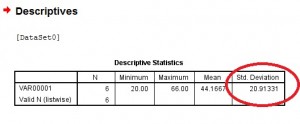
Dorsum to Top
Excel
Contents:
Excel 2013 & up
STDEV or STDEV.P?
Notes for Mac:
For Standard Divergence for an entire Population (σ) employ:
STDEV.P(A1:A10)
For Standard Departure of a Sample (a fraction of the population) use:
STDEV.South(A1:A10)
Excel 2013 & up
Lookout the video or read on below:
There are two different ways y'all can discover the standard divergence:
- The STDEV function.
- The Information Analysis Toolpak.
Consider installing the Data Analysis Toolpak, especially if you're going to exist performing multiple information analyses on your data.
one. STDEV function
Step ane: Type the information into ane column. For example, column A.
Step 2: Click in any empty cell.
Step three: Type "=STDEV(A1:A99)"—where A1:A99 are the cell locations of your data.
Step four: Click "OK."
ii. The Toolpak
Step i: Click the "Data" tab, then click "Data Analysis."
Stride two: Click on "Descriptive Statistics," and then click "OK."
Step three: Click the Input Range box, and so input where your data is. For instance, if you lot typed your information into cells B1 to B50, and so type "B1:B50" into the box.
Footstep 4: Cull the Rows or Columns radio push. This depends on how you input your data.
Pace 5: Click the "Labels in first row" box if your information has column headers. A column header is the first box in a column (e.g. A1, A2, A3…) that has some type of label, like "cats" "specimen" or "moons".
Step 6: Click the "Descriptive Statistics" cheque box.
Step 7: Choose a location for your results. For example, clicking the "New Worksheet" radio button will output your results into a new worksheet.
Step viii: Click "OK."
Back to Top
STDEV, STDEV.P, STDEV.South, STDEVA, STDEVPA and STDEVP
Sentinel the video or read on beneath:
 Excel 2013 has Half dozen functions for the standard deviation:
Excel 2013 has Half dozen functions for the standard deviation:
- STDEV,
- STDEV.P,
- STDEV.S,
- STDEVA,
- STDEVPA
- STDEVP.
Which role you choose depends on whether:
- You're working with samples or populations.
- You want to evaluate numerical information or other data types (like the binary TRUE and Simulated).
The tabular array below shows the differences between the six types.
| SAMPLE/POPULATION | Type OF Data | COMPATIBILITY*? | FUNCTION |
| SAMPLE | NUMERICAL | NO | =STDEV.S |
| SAMPLE | NUMERICAL | Yeah | =STDEV |
| SAMPLE | BOTH | N/A | =STDEVA |
| POPULATION | NUMERICAL | NO | =STDEV.P |
| POPULATION | NUMERICAL | YES | =STDEVP |
| POPULATION | BOTH | N/A | =STDEVPA |
*With earlier versions of Excel.
Back to Tiptop
TI-89 Reckoner
Watch the video for the steps:
Tin can't encounter the video? Click here.
Example problem: What is the sample Standard Difference for this list? 1, 34, 56, 89, 287, 598, 1001.
Step 1: Press HOME.
Step 2: Press CATALOG.
Information technology's located below the APPS key in the superlative center of your keypad.
Step 3: Scroll to stdDev(.
Press ENTER.
Stride four: Press 2nd, so (.
The brandish should read:
stdDev({
Note the curly bracket:
Stride five: Enter the numbers. Make sure to type in commas after each number.
The terminate result should look like this:
stdDev({1,34,56,89,287,598,1001
Footstep 6: Press 2nd, then ) twice.
This closes the expression:
stdDev({one,34,56,89,287,598,1001}).
Footstep 7: Press ENTER to get the solution:
375.149.
Back to Pinnacle
References
Gonick, L. (1993). The Cartoon Guide to Statistics. HarperPerennial.
Kenney, J. F. and Keeping, E. South. Mathematics of Statistics, Pt. ii, 2nd ed. Princeton, NJ: Van Nostrand, 1951.
Kotz, S.; et al., eds. (2006), Encyclopedia of Statistical Sciences, Wiley.
Papoulis, A. Probability, Random Variables, and Stochastic Processes, 2nd ed. New York: McGraw-Hill, pp. 144-145, 1984.
Vogt, West.P. (2005). Dictionary of Statistics & Methodology: A Nontechnical Guide for the Social Sciences. SAGE.
Lindstrom, D. (2010). Schaum's Easy Outline of Statistics, 2nd Edition (Schaum's Easy Outlines) 2nd Edition. McGraw-Loma Education
---------------------------------------------------------------------------
Demand help with a homework or test question? With Chegg Written report, you tin can get footstep-by-step solutions to your questions from an expert in the field. Your starting time 30 minutes with a Chegg tutor is free!
Comments? Need to post a correction? Please post a comment on our Facebook page .
Source: https://www.statisticshowto.com/probability-and-statistics/standard-deviation/
Posted by: mckinneychithin.blogspot.com


0 Response to "How To Find The Standard Deviation Of A Probability Distribution"
Post a Comment